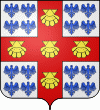Laval (Laval)
 |
 |
Laval is geographically separated from the mainland to the north by the Rivière des Mille Îles, and from the Island of Montreal to the south by the Rivière des Prairies. Laval occupies all of Île Jésus as well as the Îles Laval.
Laval constitutes one of the 17 administrative regions of Quebec, with a region code of 13, as well as a territory equivalent to a regional county municipality (TE) and census division (CD) with geographical code 65. It also constitutes the judicial district of Laval. It is the smallest administrative region in the province by area.
The first European Settlers in Laval were Jesuits, who were granted a seigneury there in 1636. Agriculture first appeared in Laval in 1670. In 1675, François de Montmorency-Laval gained control of the seigneury. In 1702 a parish municipality was founded, and dedicated to Saint-François de Sales (not to be confused with the modern-day Saint-François-de-Sales in Saguenay–Lac-Saint-Jean).
In 1845, after nearly 200 years being of a rural nature, additional municipalities began to be created. The only built-up area on the island, Sainte-Rose, was incorporated as a village in 1850, and it remained the main community for the remainder of the century. With the dawn of the 20th century came urbanization. Laval-des-Rapides became Laval's first city in 1912, followed by, which was granted village status three years later. Laval-sur-le-Lac was founded in the same year and had its tourist-based economy based on Montrealers. Laval began to grow throughout the following years because its proximity to Montreal made it an ideal suburb.
To deal with problems caused by urbanization, amalgamations occurred; L'Abord-à-Plouffe amalgamated with and Saint-Martin, creating the city of Chomedey in 1961. The amalgamation turned out to be so successful for the municipalities involved that the Quebec government decided to amalgamate the whole island into a single city of Laval in 1965, not without controversy. Laval was named after the first owner of Île Jésus, François de Montmorency-Laval, the first Roman Catholic Bishop of Quebec. At the time, Laval had a population of 170,000. Laval became a Regional County Municipality in 1980. Until then, it had been the County of Laval.
The 14 municipalities, which existed prior to the incorporation of the amalgamated City of Laval on 6 August 1965, were:
• Auteuil
• Chomedey
• Duvernay
Map - Laval (Laval)
Map
Country - Canada
 |
 |
| Flag of Canada | |
Indigenous peoples have continuously inhabited what is now Canada for thousands of years. Beginning in the 16th century, British and French expeditions explored and later settled along the Atlantic coast. As a consequence of various armed conflicts, France ceded nearly all of its colonies in North America in 1763. In 1867, with the union of three British North American colonies through Confederation, Canada was formed as a federal dominion of four provinces. This began an accretion of provinces and territories and a process of increasing autonomy from the United Kingdom. This widening autonomy was highlighted by the Statute of Westminster 1931 and culminated in the Canada Act 1982, which severed the vestiges of legal dependence on the Parliament of the United Kingdom.
Currency / Language
| ISO | Currency | Symbol | Significant figures |
|---|---|---|---|
| CAD | Canadian dollar | $ | 2 |
| ISO | Language |
|---|---|
| EN | English language |
| FR | French language |
| IU | Inuktitut |
















